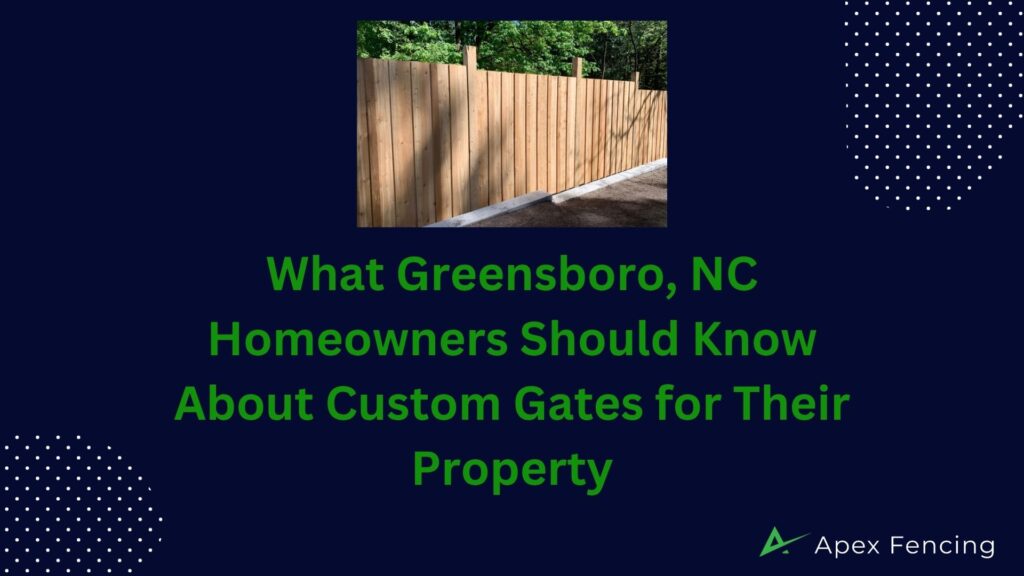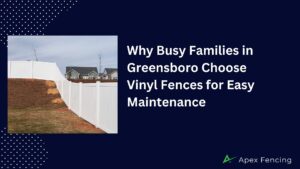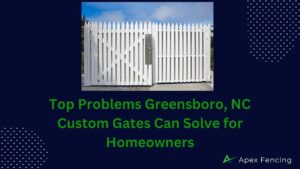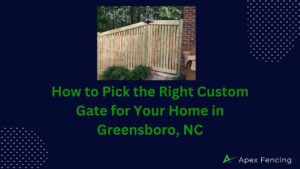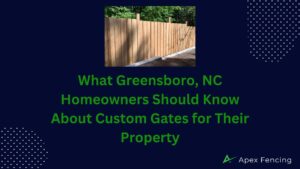Greensboro homeowners should weigh function and style when choosing a custom gate: you’ll gain increased privacy and curb appeal, but you must address site issues like slopes—a sliding gate is required for upward driveways—and safety, since gates that open into the street can create traffic hazards. Match style to your home and neighborhood rules, and pick access controls—manual, keypad or remote for convenience, or intercom for added security—that fit your daily routine and safety needs.
Key Takeaways:
- Opening direction should match driveway conditions—use sliding gates for steep drives and avoid outward swings that could encroach on Greensboro streets or traffic.
- Choose a style that complements your home (picket for older homes, clean lines for modern) and verify local building codes or HOA restrictions in Greensboro before installing.
- Select access based on trade-offs: manual for low cost, keypad/remote for convenience, and intercom or controlled entry for enhanced security.
Types of Custom Gates
You’ll choose between several functional formats based on slope, space, and traffic: sliding for uphill drives, swing for traditional entrances, bi-folding where lateral run is limited, cantilever to avoid ground tracks, and pedestrian for foot access. Consider that a sliding gate requires clear lateral space equal to the gate width and that an outward swing gate can intrude into the street. Assume that your driveway geometry and local ordinances will determine which type is feasible.
- Sliding
- Swing
- Bi-Folding
- Cantilever
- Pedestrian
| Sliding | Best for sloped drives; needs lateral run equal to gate length and minimal ground obstructions. |
| Cantilever | Good where ground tracks are impractical; requires 40–60% extra counterbalance length behind post. |
| Swing | Traditional look; needs clear swing radius and careful check for street encroachment. |
| Bi-Folding | Reduces required horizontal space by roughly half; ideal for narrow or steep entrances. |
| Pedestrian | Smaller access point for foot traffic; can integrate intercoms or keypad controls for visitors. |
Sliding Gates
Your best option for an uphill drive or where uneven ground would jam hinges, a sliding gate runs on a track or uses a cantilever system; expect to reserve lateral space equal to the gate opening and budget for a motor sized to the gate weight — typically a residential operator handles gates up to 600–800 lbs. Automated sensors and a keyed manual release keep access reliable if power fails.
Swing Gates
Swing gates offer classic curb appeal but demand a clear swinging arc; double-leaf setups often use two 8–10 ft leaves, while a single-leaf can reach 14–16 ft, and outward swings can encroach on the street, so you should verify local traffic patterns and setback rules before choosing this style.
Hinge type and opener choice affect longevity: hydraulic rams tolerate wider leaves and heavy gates better than standard electromechanical arms, and you’ll need robust posts, foundation anchors, and safety edges to meet NC residential code and prevent pinch hazards near driveways.
Bi-Folding Gates
Bi-folding gates fold back on themselves, halving the horizontal footprint and allowing a full opening where swing or slide space is limited; they work well on sloped drives and narrow right-of-ways and often use compact operators for smooth, quick cycles.
Expect more complex hardware: synchronized hinges, robust pivot brackets, and precise alignment during installation; maintenance includes periodic hinge lubrication and operator calibration, but the payoff is reduced driveway obstruction and reliable automated operation in constrained sites.
Factors to Consider When Choosing a Gate
Account for driveway slope, swing clearance and local rules: a 12% slope usually mandates a sliding gate, while an outward swing can intrude 8–10 feet into the street on narrow roads. Weigh daily use frequency, maintenance budget and noise—aluminum reduces upkeep, steel maximizes strength. Include safety sensors and an emergency manual release if you rely on automation. Recognizing the balance between security, function and curb appeal will guide the best choice for your property.
- Opening Direction
- Material
- Access Control
- Security
- Style
- Maintenance
Material Options
Choose material based on lifespan and upkeep: aluminum is lightweight, corrosion-resistant and often lasts 20+ years with powder coat; galvanized steel offers superior strength but needs proper coatings to avoid rust; wood provides warmth and costs less upfront but requires staining every 2–3 years and careful sealing. Vinyl and composites resist rot and need minimal maintenance, though they can warp in extreme heat—match material to budget, climate and desired longevity.
Security Features
Prioritize access control and fail-safes: keypads, video intercoms, CCTV (1080p+), magnetic or deadbolt locks and battery backup improve protection. Consider crash-rating only if you face vehicular threats; for typical residential use a 600–1200 lb holding-force magnetic lock paired with auto-close timers (5–30 seconds) and manual release covers most needs.
Integrate sensors and redundancy: photoelectric beam sensors and pressure edges prevent entrapment while automatic reversing mechanisms meet safety codes; choose fail-secure locks if perimeter integrity matters, or fail-safe for safe egress during power loss. Add cellular or battery backups for remote operation and log access events for audits—these systems pair with smart-home hubs for alerts and remote camera feeds.
Aesthetic Appeal
Match gate design to your home’s architecture and proportion: picket gates suit historic homes, slatted aluminum complements modern designs, and ornamental wrought iron enhances Victorian properties. Typical residential heights run 4–6 ft for front boundaries and 8–10 ft when security is prioritized; scale, sight-lines and material finish determine visual impact more than ornamentation alone.
Refine finish and lighting for lasting impact: choose powder-coat colors (matte black, bronze or custom RAL tones) that resist fading for 10–15 years, or specify patinaed copper for intentional aging. Balance picket spacing and post scale to preserve street views while maintaining privacy; integrate LED uplighting and gate-mounted fixtures to highlight details and improve nighttime recognition of visitors and vehicles.
Tips for Designing Your Custom Gate
Balance form and function: size your custom gate to match driveway width (single 10–12 ft, double 14–20 ft), pick materials—wrought iron, aluminum, cedar, or steel—based on maintenance and weight, and plan for automation space; many swing operators handle 600–1,200 lb per leaf.
- Measure twice: clearances, slope, and turning radius
- Materials: choose corrosion-resistant options for Greensboro’s humidity
- Style: match architectural era—picket for historic, minimalist for modern
- Automation: confirm operator specs and power source (solar vs hardwired)
- Permits: check HOA and city setback rules before ordering
After confirming local setback and HOA rules, finalize a scaled drawing and a hardware schedule for your contractor, specifying hinge/load ratings, finish type, and access control so installers avoid mis-specification that can cause sagging or motor failure.
Harmonizing with Landscape
Use plantings and hardscape to integrate your gate: align horizontal slats with deck or fence lines, flank drive gates with evergreen hedges like boxwood or yew for 3–5 ft screening, and choose gate height—typically 4–6 ft—to balance privacy and sightlines; add uplights or low walls to conceal posts and enhance curb appeal.
Choosing Hardware and Finishes
Select corrosion-resistant hardware—stainless or hot-dip galvanized steel—and finishes such as powder coat, which typically lasts 10–20 years in NC humidity. Confirm hinges rated to your gate’s weight (500–1,200 lb) and choose locks like magnetic strikes or keypad deadbolts for added security; verify operator compatibility with actual gate weight.
You should specify hinge types (ball-bearing for heavy swing gates, adjustable pivot for uneven terrain), choose operator voltage (24V DC for smoother, safer auto-reverse; 120V AC for higher torque), and prefer hot-dip galvanizing plus powder coating to achieve 15–25 years of corrosion resistance; inspect hardware annually, lubricate bearings, and touch up chips to prevent rust and premature failure.
Step-by-Step Process for Installation
Follow a clear sequence: survey the opening and slope, prepare footings, set plumb posts, hang the gate, wire the operator and run safety tests; consider a trusted source like Custom Wood Driveway Gates for matched hardware and wood options. Expect 24–36 inch post depths in Greensboro soils and allow concrete 48 hours to reach working strength before loading the posts.
Installation Steps
| Step | Details |
|---|---|
| Site survey | Measure width, slope, property line; call 811 to locate utilities before digging. |
| Footings & posts | Dig posts 24–36″ deep, use 2,500–4,000 PSI concrete, cure 48 hours. |
| Mount hardware | Use heavy-duty hinges/pivots sized to gate weight; maintain 1/8″–1/4″ clearance for movement. |
| Automation & wiring | Install conduit, mount operator per spec, include safety edges and photo eyes. |
| Test & finish | Run 20–30 cycles, check alignment, seal/stain wood and torque fasteners. |
Preparing the Site
Clear vegetation and grade a level run for the gate; you should mark the opening, verify setback from the street, and check slope so you can choose a swinging or sliding gate. Call 811 at least 72 hours before digging, measure for the swing arc, and plan for a 6–12″ concrete pad where the operator will sit.
Installing the Gate
Set the posts perfectly plumb with temporary bracing, pour concrete to the specified depth (typically 24–36 inches), and let it cure before attaching hinges; improper post alignment causes binding and premature hinge wear. Use stainless or hot-dipped galvanized fasteners for longevity.
Choose hinges rated for your gate’s weight—for example, a 300–400 lb wood gate needs heavy-duty pivot hinges or reinforced strap hinges—and size the operator to handle gate mass plus wind load (select a motor with at least 20–30% extra capacity). Route wiring in PVC conduit, locate limit switches precisely, and perform alignment checks within 1/8″ tolerance across the full swing to avoid rubbing against posts or gate stops.
Maintenance Considerations
Schedule regular upkeep: stain or seal wood every 2–3 years, check hinge and bolt torque biannually, and test safety devices monthly. Keep vegetation trimmed at least 2 feet from the gate line to prevent moisture accumulation and motor strain.
Plan an annual service for the operator—lubricate gearbox per manufacturer, replace batteries every 3–5 years if present, and inspect photo eyes and safety edges before winter. Track cycle counts (many operators list 10,000–50,000 cycles between major services) and retain receipts/warranty info from installation for quicker claims.
Pros and Cons of Custom Gates
| Pros | Cons |
|---|---|
| Increased curb appeal and visual impact, often boosting resale value by several percent. | Higher upfront cost: typical installs range from $2,000–$15,000 depending on materials and automation. |
| Enhanced security: physical barrier plus options like keypads and intercoms deter trespassers. | Ongoing maintenance: repainting, lubrication, and seasonal inspections add time and cost. |
| Greater privacy and controlled access for guests and deliveries. | Mechanical failures: operators and sensors can fail, requiring repairs that often cost $200–$800. |
| Convenience through automation—remote, keypad, or phone access. | Automation vulnerability to power outages; battery backup or manual override is recommended. |
| Custom materials and styles let you match historic or modern home architecture. | Material-specific issues: wood can warp in humid weather; iron can rust without proper care. |
| Added safety features available: photo-eyes, auto-reverse, and timed closers. | Safety risks from poor installation—pinch points or outward swings that encroach into the street. |
| Potential for reduced insurance premiums for gated properties. | Permit and HOA restrictions may require redesigns or approvals, delaying installation. |
| Long-term durability when properly chosen and installed (aluminum and stainless options). | Sliding gates need proper footing; shifting soil or poor drainage can cause misalignment. |
Advantages of Customization
You can select materials like wrought iron for ornate curb appeal, cedar for warmth, or aluminum for low maintenance, tailoring finishes and automation to your budget; expect material and labor to total roughly $2,000–$12,000 for common setups, with add-ons—keypad, intercom, camera—typically $300–$2,000, letting you match your gate to your home’s era and daily needs.
Potential Drawbacks to Consider
Installation delays from permit reviews or HOA approvals can add weeks; routine upkeep—painting, hinge lubrication, sensor cleaning—may cost you $100–$300 per year, and automation without backup risks lockouts during outages, so plan for overrides and warranties.
Local factors matter: Greensboro’s humidity accelerates wood and iron deterioration, sliding gates require level rails and drainage to avoid tracking issues, and outward-swing designs can violate setback rules or create traffic hazards; get a written estimate, ask for local permit experience, and require a contractor warranty (12–24 months) to protect against early mechanical or installation defects.
Summing up
Choosing the right custom gate for your Greensboro property is about balancing function, safety, and curb appeal. The right design depends on driveway conditions—sliding gates work best on uphill slopes, while swing or bi-fold options fit flat or narrow entrances. Homeowners must also weigh local codes, HOA rules, and traffic safety to avoid issues with outward swings or street encroachment.
Material choice affects both longevity and upkeep: aluminum offers low maintenance, steel provides maximum strength, and wood delivers natural charm with higher upkeep. Automation and access control—whether manual, keypad, remote, or intercom—add layers of convenience and security, while design choices ensure your gate complements your home’s style and neighborhood character.
By considering slope, space, style, materials, and safety features, Greensboro homeowners can install a custom gate that enhances privacy, boosts property value, and improves everyday convenience.
👉 If you’re ready to upgrade your home with a custom gate in Greensboro, NC, trust Apex Fencing. We specialize in designing and installing gates tailored to your property’s unique needs, combining craftsmanship, durability, and local code expertise. From modern sliding gates to classic wrought iron designs, our team ensures your gate is built to last—and built to impress.
Contact Apex Fencing today to schedule your free consultation and discover how a custom gate can transform your property.
FAQ
Q: What should Greensboro homeowners consider about the opening direction of a custom gate?
A: Choose opening style based on driveway grade, available clearance and street conditions. Swing gates can open inward or outward or slide sideways; a sloped driveway generally requires a sliding gate because a swinging gate may bind. If the gate will open toward the street, check traffic flow, sightlines and local ordinances so the gate does not obstruct vehicles or violate setback rules. Factor in swing radius, nearby landscaping, pedestrian paths and snowplow access so the gate operates safely year-round.
Q: How do I pick a gate style that fits my Greensboro property?
A: Match the gate design and material to your home’s architecture and neighborhood requirements. Older homes pair well with picket or ornamental ironwork; contemporary homes suit clean, minimal aluminum or steel. Consider visibility versus privacy (open pickets vs solid panels), durability and maintenance (wood needs more upkeep than powder‑coated metal), finish and paint choices, and any HOA or historic district design rules. Balance aesthetics with budget and long‑term maintenance costs.
Q: What access and security options should I consider for a custom gate?
A: Decide between manual and automated operation based on convenience and security needs. Manual gates are less expensive but require exiting the vehicle; automated options include remote control, keypad, smartphone control, card readers and gate operators with safety sensors. For higher security, add an intercom or video intercom and integrate lighting or alarm systems. Ensure installations include safety features (photo‑eyes, edge sensors), battery backup or manual release for power outages, and professional setup to meet electrical and local code requirements.

